Search results for: 'block di'
- Related search terms
- block
- block diagram
- block+diagra
- block+diagr
- block foam cutting
-
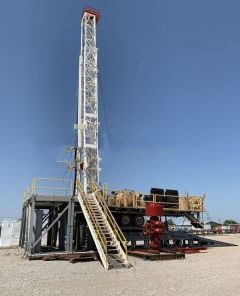 TT-2294 SPENCER HARRIS 7000 TRAILER MOUNTED DRILLING RIG 700HPTT-2294 SPENCER HARRIS 7000 TRAILER MOUNTED DRILLING RIG 700HP 700HP SPENCER HARRIS 7000 TRAILER MOUNTED DRILLING RIG USED DRILLING RIG 700HP CONDITION: GOOD QUANTITY: 1 Learn More
TT-2294 SPENCER HARRIS 7000 TRAILER MOUNTED DRILLING RIG 700HPTT-2294 SPENCER HARRIS 7000 TRAILER MOUNTED DRILLING RIG 700HP 700HP SPENCER HARRIS 7000 TRAILER MOUNTED DRILLING RIG USED DRILLING RIG 700HP CONDITION: GOOD QUANTITY: 1 Learn More -
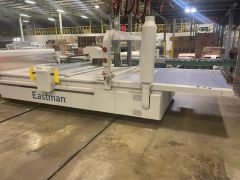 J-4496 EASTMAN RAPTOR 75X- 78X7-5J-4496 EASTMAN RAPTOR 75X- 78X7-5 MACHINE IS PRACTICALLY NEW, ONLY RAN ABOUT 200 HOURS IN PERFECT RUNNING CONDITION AVAILABLE IMMEDIATELY MADE IN THE USA STANDARD EQUIPMENT RECIPROCATING STRAIGHT KNIFE WITH QUICK-REMOVAL CLAMP, 10 SPARE BLADES 2 AUTOMATED SHARPENING DISCS, 1 EXTRA SET OF DISCS INCLUDED (CHOICE OF: 60,80,100, OR 150 GRIT) Learn More
J-4496 EASTMAN RAPTOR 75X- 78X7-5J-4496 EASTMAN RAPTOR 75X- 78X7-5 MACHINE IS PRACTICALLY NEW, ONLY RAN ABOUT 200 HOURS IN PERFECT RUNNING CONDITION AVAILABLE IMMEDIATELY MADE IN THE USA STANDARD EQUIPMENT RECIPROCATING STRAIGHT KNIFE WITH QUICK-REMOVAL CLAMP, 10 SPARE BLADES 2 AUTOMATED SHARPENING DISCS, 1 EXTRA SET OF DISCS INCLUDED (CHOICE OF: 60,80,100, OR 150 GRIT) Learn More -
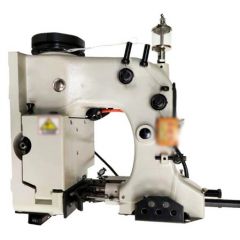 YY-1366 (USERS MANUAL) BAG CLOSING MACHINE HEAD, INSTRUCTION MANUALYY-1366 BAG CLOSING MACHINE HEAD, INSTRUCTION MANUAL FOR OPENRATOR SAFETY: - THIS MANUAL BOOK CONTAINS INSTRUCTIONS AND PRECAUTIONS FOR USING THE BAG CLOSING MACHINE HEAD. BE SURE TO READ AND UNDERSTAND THE MANUAL BOOK BEFORE USING THE MACHINES. - KEEP THIS MANUAL BOOK NEAR THE SEWING MACHINE FOR REFERENCE. BE SURE TO ATTACH THIS MANUAL BOOK TO THE MACHINE WHEN LENDING OR TRANSFER IT TO ANOTHER PERSON OR COMPANY. - PLEASE CONTACT THIS MANUAL BOOK FROM US IF IT LOST. - THE CONTENTS OF THIS MANUAL BOOK ARE SUBJECT TO CHANGE WITHOUT PRIOR NOTICE FOR IMPROVEMENT AND SAFETY PURPOSE. Learn More
YY-1366 (USERS MANUAL) BAG CLOSING MACHINE HEAD, INSTRUCTION MANUALYY-1366 BAG CLOSING MACHINE HEAD, INSTRUCTION MANUAL FOR OPENRATOR SAFETY: - THIS MANUAL BOOK CONTAINS INSTRUCTIONS AND PRECAUTIONS FOR USING THE BAG CLOSING MACHINE HEAD. BE SURE TO READ AND UNDERSTAND THE MANUAL BOOK BEFORE USING THE MACHINES. - KEEP THIS MANUAL BOOK NEAR THE SEWING MACHINE FOR REFERENCE. BE SURE TO ATTACH THIS MANUAL BOOK TO THE MACHINE WHEN LENDING OR TRANSFER IT TO ANOTHER PERSON OR COMPANY. - PLEASE CONTACT THIS MANUAL BOOK FROM US IF IT LOST. - THE CONTENTS OF THIS MANUAL BOOK ARE SUBJECT TO CHANGE WITHOUT PRIOR NOTICE FOR IMPROVEMENT AND SAFETY PURPOSE. Learn More -
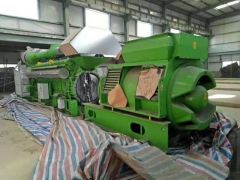 T-6968 JENBACHER J626 GS-H102 4400KW 50Hz 10500V-SURPLUS NEW, YEAR 2018T-6968 JENBACHER J626 GS-H102 4400KW 50Hz 10500V-SURPLUS NEW, YEAR 2018 QUANTITY: 2 Learn More
T-6968 JENBACHER J626 GS-H102 4400KW 50Hz 10500V-SURPLUS NEW, YEAR 2018T-6968 JENBACHER J626 GS-H102 4400KW 50Hz 10500V-SURPLUS NEW, YEAR 2018 QUANTITY: 2 Learn More -
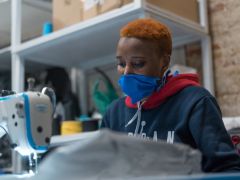 D-2388 What’s the Best Material for a Mask?
D-2388 What’s the Best Material for a Mask?Federal health officials have now recommended that we cover our faces with fabric during the coronavirus pandemic. But what material offers the most protection?
The Centers for Disease Control and Prevention has posted a no-sew mask pattern using a bandanna and a coffee filter as well as a video on making masks using rubber bands and folded fabrics found at home.
While a simple face covering can reduce the spread of coronavirus by blocking outgoing germs from coughs or sneezes of an infected person, experts say there is more variation in how much homemade masks might protect the wearer from incoming germs, depending on the fit and quality of the material used.
Scientists around the country have taken it upon themselves to identify everyday materials that do a better job of filtering microscopic particles. In recent tests, HEPA furnace filters scored well, as did vacuum cleaner bags, layers of 600-count pillowcases and fabric similar to flannel pajamas. Stacked coffee filters had medium scores. Scarves and bandanna material had the lowest scores, but still captured a small percentage of particles.
If you don’t have any of the materials that were tested, a simple light test can help you decide whether a fabric is a good candidate for a mask.
“Hold it up to a bright light,” said Dr. Scott Segal, chairman of anesthesiology at Wake Forest Baptist Health who recently studied homemade masks. “If light passes really easily through the fibers and you can almost see the fibers, it’s not a good fabric. If it’s a denser weave of thicker material and light doesn’t pass through it as much, that’s the material you want to use.”
Researchers say it’s important to remember that lab studies are conducted under perfect conditions with no leaks or gaps in the mask, but the test methods give us a way to compare materials. And while the degree of filtration for some homemade masks seems low, most of us — who are staying home and practicing social distancing in public — don’t need the high level of protection required for medical workers. More important, any face covering is better than none, especially if worn by a person who has the virus but doesn’t know it.
The biggest challenge of choosing a homemade mask material is to find a fabric that is dense enough to capture viral particles, but breathable enough that we can actually wear it. Some items being touted online promise high filtration scores, but the material would be unwearable.
Dressing Up for Work … at Home
Yang Wang, an assistant professor of environmental engineering at Missouri University of Science and Technology, worked with his graduate students to study various combinations of layered materials — including both air filters and fabric. “You need something that is efficient for removing particles, but you also need to breathe,” said Dr. Wang, who last fall won an international award for aerosol research.To test everyday materials, scientists are using methods similar to those used to test medical masks, which everybody agrees should be saved for medical workers who are exposed to high doses of virus from seeing infected patients. The best medical mask — called the N95 respirator — filters out at least 95 percent of particles as small as 0.3 microns. By comparison, a typical surgical mask — made using a rectangular piece of pleated fabric with elastic ear loops — has a filtration efficiency ranging from 60 to 80 percent.
Dr. Wang’s group tested two types of air filters. An allergy-reduction HVAC filter worked the best, capturing 89 percent of particles with one layer and 94 percent with two layers. A furnace filter captured 75 percent with two layers, but required six layers to achieve 95 percent. To find a filter similar to those tested, look for a minimum efficiency reporting value (MERV) rating of 12 or higher or a microparticle performance rating of 1900 or higher.
The problem with air filters is that they potentially could shed small fibers that would be risky to inhale. So if you want to use a filter, you need to sandwich the filter between two layers of cotton fabric. Dr. Wang said one of his grad students made his own mask by following the instructions in the C.D.C. video, but adding several layers of filter material inside a bandanna.
Dr. Wang’s group also found that when certain common fabrics were used, two layers offered far less protection than four layers. A 600 thread count pillow case captured just 22 percent of particles when doubled, but four layers captured nearly 60 percent. A thick woolen yarn scarf filtered 21 percent of particles in two layers, and 48.8 percent in four layers. A 100 percent cotton bandanna did the worst, capturing only 18.2 percent when doubled, and just 19.5 percent in four layers.
The group also tested Brew Rite and Natural Brew basket-style coffee filters, which, when stacked in three layers, showed 40 to 50 percent filtration efficiency — but they were less breathable than other options.
If you are lucky enough to know a quilter, ask them to make you a mask. Tests performed at the Wake Forest Institute for Regenerative Medicine in Winston-Salem, N.C., showed good results for homemade masks using quilting fabric. Dr. Segal, of Wake Forest Baptist Health, who led the study, noted that quilters tend to use high-quality, high-thread count cotton. The best homemade masks in his study were as good as surgical masks or slightly better, testing in the range of 70 to 79 percent filtration. Homemade masks that used flimsier fabric tested as low as 1 percent filtration, Dr. Segal said.
The best-performing designs were a mask constructed of two layers of high-quality, heavyweight “quilter’s cotton,” a two-layer mask made with thick batik fabric, and a double-layer mask with an inner layer of flannel and outer layer of cotton.
Bonnie Browning, executive show director for the American Quilter’s Society, said that quilters prefer tightly woven cottons and batik fabrics that stand up over time. Ms. Browning said most sewing machines can handle only two layers of fabric when making a pleated mask, but someone who wanted four layers of protection could wear two masks at a time.
Ms. Browning said she recently reached out to quilters on Facebook and heard from 71 people who have made a combined total of nearly 15,000 masks. “We quilters are very much in the thick of what’s going on with this,” said Ms. Browning, who lives in Paducah, Ky. “One thing most of us have is a stash of fabric.”
People who don’t sew could try a folded origami mask, created by Jiangmei Wu, assistant professor of interior design at Indiana University. Ms. Wu, who is known for her breathtaking folded artwork, said she began designing a folded mask out of a medical and building material called Tyvek, as well as vacuum bags, after her brother in Hong Kong, where mask wearing is common, suggested it. (DuPont, the maker of Tyvek, said in a statement that Tyvek is intended for medical apparel, not masks.) The folded mask pattern is free online, as is a video demonstrating the folding process. In tests at Missouri University and University of Virginia, scientists found that vacuum bags removed between 60 percent and 87 percent of particles. But some brands of vacuum bags may contain fiberglass or are harder to breathe through than other materials, and shouldn’t be used. Ms. Wu used a bag by EnviroCare Technologies, which has said it does not use fiberglass in its paper and synthetic cloth bags.
“I wanted to create an alternative for people who don’t sew,” said Ms. Wu, who said she is talking to various groups to find other materials that will be effective in a folded mask. “Given the shortage of all kinds of materials, even vacuum bags might run out.”
The scientists who conducted the tests used a standard of 0.3 microns because that is the measure used by the National Institute for Occupational Safety and Health for medical masks.
Linsey Marr, a Virginia Tech aerosol scientist and an expert in the transmission of viruses, said the certification method for respirators and HEPA filters focuses on 0.3 microns because particles around that size are the hardest to catch. While it seems counterintuitive, particles smaller than 0.1 microns are actually easier to catch because they have a lot of random motion that makes them bump into the filter fibers, she said.
“Even though coronavirus is around 0.1 microns, it floats around in a wide range of sizes, from around 0.2 to several hundred microns, because people shed the virus in respiratory fluid droplets that also contain lots of salts and proteins and other things,” said Dr. Marr. “Even if the water in the droplets fully evaporates, there’s still a lot of salt and proteins and other gunk that stays behind as solid or gel-like material. I think 0.3 microns is still useful for guidance because the minimum filtration efficiency will be somewhere around this size, and it’s what NIOSH uses.”
Learn More -
 How To Choose an N95 Respirator Mask For Coronavirus Prevention? All You Need to Know Before Buying Face Masks
How To Choose an N95 Respirator Mask For Coronavirus Prevention? All You Need to Know Before Buying Face MasksHow To Choose an N95 Respirator Mask For Coronavirus Prevention? All You Need to Know Before Buying Face Masks.
1. What’s an N95 mask?
An N95 respirator is a respiratory protective face mask, designed to help reduce the user’s exposure to airborne particles including very small particles (0.3 microns) and large droplets. N95 respirator face mask literally has a filtration efficiency of at least 95% against non-oily particles.
2. Differences between N95 mask and surgical mask?
Generally, the N95mask also includes an N95 surgical mask. So, here we will just compare a standard N95 particulate mask with a disposable surgical mask. Surgical masks are designed to be worn by healthcare professionals during surgery and nursing, to help prevent contamination of the surgical field or the patient by capturing liquid droplets that are expelled by the user.
An N95 particulate mask blocks at least 95 percent of very small (0.3 microns) test particles, and while a disposable surgical mask is fluid-resistant and protects the user against large particles (5 microns), droplets, sprays or splatter.
Different from a loose-fitting, disposable surgical mask, an N5 mask is tight-fitting to achieve a very close facial fit, which guarantees a minimal leakage around the edges of the mask when the user inhales. If properly fitted, the filtration capabilities of N95 respirators exceed those of disposable surgical face masks.Speaking of the N95 mask price and disposable surgical mask price, the N95 respirator mask is pricier than a surgical mask. In contrast, the N95 mask is reusable but the common surgical mask is disposable. Strictly speaking, N95 respirator masks should be worn for a maximum of eight hours while the disposable surgical mask is recommended to be replaced every four hours.
However, during the novel coronavirus outbreak, face masks are in short supply and everyone discards one or two face masks every day. A surgical mask could be used for a whole day in a good condition of no damage, no moisture, and no deformation. According to some researches, the N95 respirator mask used for two days still maintains a filtration efficiency of at least 95%, while the filtration efficiency of an N95 respirator used for three days reduced to 94.7%. So, if an N95 respirator is in good maintenance, you can wear it for at least 2 days, a week, maybe even a month.
3. Types of N95 mask
Generally, according to their intended use, the types of N95 masks include the standard N95 particulate respirators and N95 surgical respirator masks. Additionally, there are N95 masks with a breathing valve or not.
1) Differences between standard N95 particulate respirator and N95 surgical mask:
How to differentiate standard N95 particulate-filtering respirators and N95 surgical masks? The N95 surgical mask is literally a combination of N95 respirator and surgical mask, it is both certificated by NIOSH as an N95 respirator and also cleared by the FDA as a surgical mask. N95 surgical respirator masks are also referred to as medical respirators, healthcare respirators, or surgical N95s.
The significant difference between a standard N95 particulate respirator and an N95 surgical mask is that the N95 surgical mask is fluid-resistant while the standard N95 particulate respirator is not.
An N95 particulate respirator, also called N95 dust mask or N95 pollution mask, helps reduce very small particles inhaled by the user, and it is used for respiratory protection when the user might be exposed to particulate hazards. With a fluid resistance plus, an N95 surgical mask help reduce particles both inhaled and exhaled by the user, it is designed to be used during surgery and nursing tasks, whatever the user requires respiratory protection, expelled particulates or requires fluid resistance.
2) Differences between N95 masks with a breathing valve or not:
Many people question: Is an N95 mask with an exhalation valve better than the one without a valve?
In fact, the N95 respirators with an exhalation valve are not recommended to be used for coronavirus prevention, because the valve is a one-way vent that couldn’t keep your exhalation to yourself. It means that this valved N95 mask makes your breathing out easier and helps reduce heat build-up to avoid fogging up your glasses, however, it’s not that friendly to others.
Besides, the N95 mask with the valve is pricier than the one without a valve.4. What are the differences between N95, KN95, FFP2, and KF94?
When you search for the N95 respirators, there are many respirators such as KN95, FFP2, and KF94 that appeared in the same breath. What’s different between these respirators of different letters?
Actually, both the N95, KN95, FFP2 and KF94 respirators have almost the same filtration efficiency, it means that KN95, FFP2, and KF94 are as effective as the N95 respirator mask. The main difference between these respirators is that they are tested by different nations.
The N95 mask has a full name of NIOSH-certified N95 respirator, which means these respirators are tested of 95% filtration and certified by the U.S. National Institute of Occupational Safety and Health (NIOSH). The KN95 respirator is a particulate-filtering mask tested using the China criteria. The FFP2 is a filtering facepiece score of 94% filter capacity approved by Europe, and the KF94 is tested by Korea criteria.
To simply put, we could put these respirators into an equation as below:
N100 (99.97%) = FFP3 (99.95%) > N95 (95%) = KN95 (95%) = FFP2 (94%) = KF94 (94%) > KN90 (90%).
Learn More
Anti Virus Flu Mask Meets FFP2 N95 KN95 KF94 Guidance -
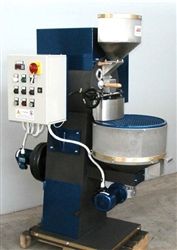 P-5044 STA IMPIANTI ROASTER 5 KILOS
P-5044 STA IMPIANTI ROASTER 5 KILOSP-5044 STA IMPIANTI ROASTER 5 KILOS
STA
MODEL: IMPIANTI
ROASTER
5 KILOS
STA IS A MANUFACTURING GROUP IN ITALY - THAT IS MADE UP OF SEASONED ENGINEERS FROM MOST OF THE BIG OLD ITALIAN ROASTING MACHINE MAKERS - SO THEIR SCOPE OF KNOWLEDGE AND HISTORY IS FANTASTIC. BASICALLY - THEIR CLAIM TO FAME IS HOT AIR INTRODUCED INTO THE TOP OF THE ROASTING CHAMBER . . . BEING PULLED THROUGH THE TURBULATING COFFEE AND EXITING THROUGH DRUM PERFORATIONS INTO THE BOTTOM. FIRST, THAT MAKES IT REALLY FRIENDLY TO BLENDING FORMULAS AND SECOND IT MAKES FOR SMALLER CHAFF - AS THE TURNING COFFEE BEATS IT UP A LITTLE AND THUS THE ROAST COMES OUT MORE CLEAN THAN THE OLD DAYS OF SOME SOLID DRUMS . . . SO IT IS DIFFERENT - WHICH DOES NOT MAKE IT BETTER - BUT IF YOU HAVE A BACKGROUND ON JABEZ BURNS . . THEN YOU WILL REALLY LOVE THIS PRODUCTION. BIG NATURALLY DEVELOPED BEANS - VERY EVEN ROAST. FOLLOWING IS THE MANUFACTURERS SPECS AND WE WILL BE GLAD TO DISCUSS MORE IN-DEPTH AS YOU HAVE QUESTIONS.ROASTING MACHINES LINE, PARTICULARLY SUITABLE FOR LITTLE PRODUCTION ACTIVITIES OF HIGH QUALITY ROASTED COFFEE, SUCH AS SHOPS, PASTRIES OR ARTISAN LABORATORIES. SMALL SIZE, TECHNOLOGICALLY ADVANCED, CONFIRM THEM ELVES AS IDEAL TOOL FOR THE PRODUCTION OF SELECTED COFFEES IN LITTLE QUANTITY. MADE WITH THE SAME REQUIREMENTS FOR RELIABILITY AND SECURITY FEATURES OF THE BIGGER AND MORE SOPHISTICATED INDUSTRIAL ROASTING MACHINES, ARE AVAILABLE WITH HEATING GENERATOR TYPE GAS BURNER (AVAILABLE ALSO BY ELECTRIC RESISTANCES) AND AUTOMATIC CONTROL SYSTEM WITH SEMIAUTOMATIC MANAGEMENT.
TECHNICAL DATA:
ROASTER CAPACITY: 5 KG. - MAX. 7 KG. CYCLE
ROASTING CYCLE: 9 MINUTES ÷ 20
RAW COFFEE PROCESSING PER HOUR: 20 KG. ÷ 30
INSTALLED ELECTRIC POWER: 0.9 KW | SINGLEPHASE 220 VOLTS 50 HZ
THERMAL POWER (NATURAL GAS OR LPG): 8000 KCAL/H
MAIN COMPONENTS:
HOPPER OF CHARGE IN STAINLESS STEEL
ROASTING DRUM
HEATING GENERATOR OF NEW GENERATION, PATENTED AND COMPLETE OF BURNER
RAMP VALVES FOR GAS SAFETY AND ELECTRIC DEVICE TO CHECK FLAMES RATIFIED AND COMPLETE OF ALARM SIGNAL
COOLING TANK IN STAINLESS STEEL
SAFETY PREVENTION SYSTEM ON THE COOLING TANK
SUPPORTING FRAME FOR THE OVER INDICATED COMPONENTS
ELECTRIC CONTROL BOARD MADE ACCORDING CE RULES, INTEGRATED, COMPLETE OF PLC + TOUCH SCREEN DEVICE FOR ROASTING MACHINE CONTROL AND MANAGEMENT.
INDEPENDENT FANS FOR THE ROASTING DRUM AND THE COOLING TANK
INDEPENDENT MOTORS FOR THE ROASTING DRUM AND THE COOLING TANK
CYCLONE FOR CHAFFS COLLECTING
DETAILS OF COMPONENTS:
HOPPER OF CHARGE IN STAINLESS STEEL WITH MANUAL IN-LET OF COFFEE WITH DOORUNLOADING SYSTEM.
ROASTING DRUM: MADE BY A FIXED ELEMENT WITH DOUBLE WALLS INSULATED FOR THERMAL PROTECTION AND SUPPORT OF THE ROTATING CYLINDER MOVING THE PRODUCT. SUCH CYLINDER, COMPLETELY MADE IN COMPOUND STEEL TO OVERCOME THE THERMAL CHANGES, IS DEVELOPED WITH A PERFORATED PLATE FOR THE CONTAINMENT AND SPECIAL BLENDERS ON THE RIGHT AND LEFT SIDE PLACED ON DIFFERENT LEVELS TO GET A PERFECT BLENDING OF COFFEE. AT THE END OF THE ROASTING CYCLE, THE PRODUCT UNLOADING IS ALLOWED BY A WIDE DOOR WITH MANUAL OPENING/CLOSING SYSTEM.
HEATING GAS GENERATOR OF NEW CONCEPT, PATENTED, COMPLETE OF BURNER, RAMP VALVES FOR GAS SAFETY AND ELECTRONIC EQUIPMENTS FOR FLAME CONTROL RATIFIED AND COMPLETE OF SIGNALLING ALARM.
COOLING TANK IN STAINLESS STEEL: WIDE SURFACE PERFORATED WITH TWO ARMS AND CROSSED FLOWS. UNLOADING MOUTH WITH HAND DRIVE.
SUPPORTING FRAME: MONO-BLOCK, PLATE PRESS-BENDED, STEEL MADE, SUPPORTING THE COMPONENTS PREVIOUSLY DESCRIBED.
SAFETY PROTECTION FOR COOLING TANK
ELECTRIC CONTROL BOARD FOR MACHINE MANAGEMENT ACCORDING CE RULES INTEGRATED. COMPLETE OF PLC + TOUCH SCREEN FOR ROASTING MACHINE CONTROL AND MANAGEMENT.
POSSIBLE RECORDING OF ROASTING PARAMETERS
CYCLONE FOR CHAFFS COLLECTING.
INDEPENDENT MOTORIZATION FOR ROASTING DRUM AND COOLING TANK
INDEPENDENT ELECTRIC-FAN FOR ROASTING DRUM AND ELECTRIC –FAN FOR COOLING TANK.QUANTITY: 1
Learn More -
 M-4096 BOTTLING LINE FOR RETURNABLE GLASS BOTTLES YEAR 1985-1999 – 45,000BPH CAPACITY
M-4096 BOTTLING LINE FOR RETURNABLE GLASS BOTTLES YEAR 1985-1999 – 45,000BPH CAPACITYREFERENCE NUMBER: M-4096
BOTTLING LINE FOR RETURNABLE GLASS BOTTLES YEAR 1985-1999 – 45,000BPH CAPACITY
BOTTLING LINE:
CAPACITY: MAX. 45.000 BPH
BOTTLES: 0,25 – 0,5 – 0,7 – 0,75 L GLASS
CAPS: ALUMINIUM SCREW CAPS, CROWN CORKS
LABELS: BODY, NECK, BACK
PACKAGING: 3 X 4 – 4 X 5 – 4 X 6 PLASTIC CRATES
PALLETS: BRUNNEN AND EURO
PRODUCT: FLAT WATER, CSD, BEER
VOLTAGE: 400 V / 3 PH / 50HZ
01 PALLET FEEDER, SCHÄFER YEAR 1985
02 PALLET RELEASE MACHINE, BORNBINDER PAE, YEAR 1999
03 DEPALLETIZER, SCHÄFER T-INTEL.MU, YEAR 1989
04 CRATE SWITCH POINT, YEAR 1989
05 CRATE SORTING, RECOP, YEAR 1989
06 DECRATER, KETTNER KONTI A-570, YEAR 1989
07 CRATE WASHER, YEAR 1989
08 BOTTLE SORTING, RECOP, YEAR 1989
09 BOTTLE DISCHARGE, ALCOA SD602 CCD, YEAR 1989
10 DESCREW MACHINE, ALCOA DC 2490Z, YEAR 1989
11 BOTTLE WASHER, O+H E44AD 420-11, YEAR 1989
12 AQUAREX, REHMANN, YEAR 1989
13 EMPTY BOTTLE INSPECTOR, KRONES 712-M1, YEAR 1999
14 FILLER, O+H B120-115, 20SV, 15KK, YEAR 1989
15 CAPS FEEDER, ALCOA, YEAR 1989
16 LABELLER, KRONES, BLOCKED WITH FILLER, YEAR 1989
17 PREMIXER, O+H INTERMIX, 39 M³/H, YEAR 1989
18 FILL HEIGHT CHECK DEVICE; RECOP, YEAR 1989
19 BOTTLE BURST, RECOP, YEAR 1989
20 BOTTLE DISCHARGE, ALCOA SD602 CCD, YEAR 1989
21 CRATER, KETTNER KONTI A-570, YEAR 1989
22 PALLETIZER, SCHÄFER T-INTEL.MU, YEAR 1989
23 PALLET BINDER, BORNBINDER PAE, YEAR 1989
24 PALLET OUTLET, SCHÄFER, YEAR 1999
25 PALLET MAGAZINE, SCHÄFER, YEAR 1999
26 PALLET CHECK DEVICE, SCHÄFER, YEAR 1999
27 CONVEYORS, YEAR 1989
28 CRATE TURNER, YEAR 1989
CAPACITY PER HOUR:
Learn More
# APPROX. 15,000 L BASED ON 500 ML BOTTLES (30,000 BPH)
# APPROX. 12,500 L BASED ON 12 OZ BOTTLES (35,000 BPH)
500 ML BOTTLES:
# APPROX. 120,000 L IN 8 HOURS
# APPROX. 360,000L IN 24 HOURS
12 OZ BOTTLES:
# APPROX. 100,000 L IN 8 HOURS
# APPROX. 300,000 L IN 24 HOURS -
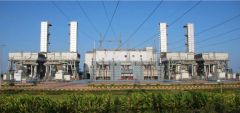 C-3994 BARGEMOUNTED POWER PLANT, CAPACITY 220MW
C-3994 BARGEMOUNTED POWER PLANT, CAPACITY 220MWC-3994 BARGEMOUNTED POWER PLANT, CAPACITY 220MW
A. ONCE THROUGH STEAM GENERATOR
B. BARGE
C. CHILLERS
D. AIR COMPRESSOR
E. GAS TURBINE
F. STEAM TURBINE
G. FEEDWATER SYSTEM
H. CLOSED COOLING WATER SYSTEM
I. AUXILIARY COOLING WATER SYSTEM
J. CONDENSATE POLISHING UNIT (CPU)
K. WASTE WATER SYSTEM
L. PLANT ELECTRICAL SYSTEM
M. BLACK START DG SET
N. PLANT CONTROLS AND INSTRUMENTATION
O. PLANT FIRE FIGHTING SYSTEM
P. START UP VACUUM SYSTEM
Q. STEAM TURBINE DEAERATING CONDENSERQUANTITY: 1 PLANT
Learn More -
 K-4726 VACUUM MATTRESS PACKING MACHINEREFERENCE NUMBER: K-4726 VACUUM MATTRESS PACKING MACHINE CONTROL PANEL MACHINE COMPLETE WITH MONITOR TOUCH SCREEN WITH ABILITY TO CUSTOMIZE FEATURES FOR PRODUCTION CONTROL, TIMER, SET RROGRAM, ETC. HYDRAULIC PRESS POWER PRESS: 100 TONS INCREASE WORKING HEIGHT: 2200mm X 2200mm X 405mm 600mm ELECTRIC HOIST FOR LOADING ROLLS WITH A CAPACITY OF 250 KGS OR 500 KGS TRANSFER 220 D: BLOCK PLACED AFTER THE HYDRAULIC PRESS TO MAKE A PACKAGE OF DOUBLE MATTRESS WITH 2 COILS ADDITIONAL POSSIBLE TO INSERT PIECES OF POLYETHYLENE PACKAGING OTHER THAN THE FIRST. REEL DIAMETER VARIABLE CASTLE OUTPUT FROM 280mm TO 500mm. VARIABLE DIAMETER REEL WITH PLUS-FUNCTION AUTOMATIC: DUAL EXHAUST, SIDE OR REAR, WITH AUTOMATIC MATTRESS PACKAGING AND UNLOADING TRUCKS. MODEM PROVIDES FOR FULL CONTROL BY TELECARE. QUANTITY AVAILABLE: 1 Learn More
K-4726 VACUUM MATTRESS PACKING MACHINEREFERENCE NUMBER: K-4726 VACUUM MATTRESS PACKING MACHINE CONTROL PANEL MACHINE COMPLETE WITH MONITOR TOUCH SCREEN WITH ABILITY TO CUSTOMIZE FEATURES FOR PRODUCTION CONTROL, TIMER, SET RROGRAM, ETC. HYDRAULIC PRESS POWER PRESS: 100 TONS INCREASE WORKING HEIGHT: 2200mm X 2200mm X 405mm 600mm ELECTRIC HOIST FOR LOADING ROLLS WITH A CAPACITY OF 250 KGS OR 500 KGS TRANSFER 220 D: BLOCK PLACED AFTER THE HYDRAULIC PRESS TO MAKE A PACKAGE OF DOUBLE MATTRESS WITH 2 COILS ADDITIONAL POSSIBLE TO INSERT PIECES OF POLYETHYLENE PACKAGING OTHER THAN THE FIRST. REEL DIAMETER VARIABLE CASTLE OUTPUT FROM 280mm TO 500mm. VARIABLE DIAMETER REEL WITH PLUS-FUNCTION AUTOMATIC: DUAL EXHAUST, SIDE OR REAR, WITH AUTOMATIC MATTRESS PACKAGING AND UNLOADING TRUCKS. MODEM PROVIDES FOR FULL CONTROL BY TELECARE. QUANTITY AVAILABLE: 1 Learn More
